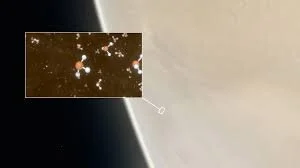This week’s entry covers possible trouble for ΛCDM from merging clusters, a new state-of-the-art calculation of the effective number of neutrinos Neff, and a 5% test of spatial variations of Newton’s constant from the Large Magellanic Cloud. Enjoy the read!
Top arXiv papers from Week 49, 2020
Top arXiv papers from Week 48, 2020
This week’s entry looks at the first measurement of the cosmic birefringence angle from the CMB, the generation of large primordial non-Gaussianity from Higgs-induced modulated reheating, and a quasi-model-independent inference of the Hubble constant and the late-time expansion. Happy Thanksgiving to my American readers!
Top arXiv papers from Week 46, 2020
This week’s entry deals with new measurements of the Deuterium-to-Helium-3 cross-section with extremely important implications for Big Bang Nucleosynthesis, and two papers on axion-photon conversion (and vice-versa) in astrophysical environments. A heads-up that next week’s blog installment will likely be cancelled due to personal reasons (see here). Enjoy!
Busy note 3
Top arXiv papers from Week 45, 2020
Top arXiv papers from Week 44, 2020
This week I cover a rebuttal against the claims of having detected phosphine (possibly connected to life) on Venus, a proposal for solving the core-cusp problem using late-time dark matter oscillations, and how self-interacting dark matter could provide the seeds for the observed supermassive black holes. This week I've found it particularly important to repeat a few important caveats: my covering particular papers does not necessarily mean I endorse the science or the writing style, just that I found the paper particularly interesting (it may even be directly outside my field of research). In other words, your mileage may vary, so don’t forget to take whatever you read here with a grain of salt. One thing I’m starting to do from this week on is to explicitly point out when a certain paper has been signed alphabetically (which is often the case within hep and gr-qc), in an attempt to hopefully give more visibility to early-career physicists whose last name initials, due to no fault of their own, reside in the second half of the alphabet.
Top arXiv papers from Week 43, 2020
Top arXiv papers from Week 42, 2020
Top arXiv papers from Week 41, 2020
After disappearing for a week, this week I cover three papers discussing why reducing the sound horizon is necessary but not sufficient to solve the Hubble tension, how to probe gravitational waves using astrometry, and whether unparticles might have something to do with dark energy. As of this week I’ve also decided to start including plots from the respective papers, where necessary, in my summaries, as a good plot is worth a thousand words. Enjoy!










